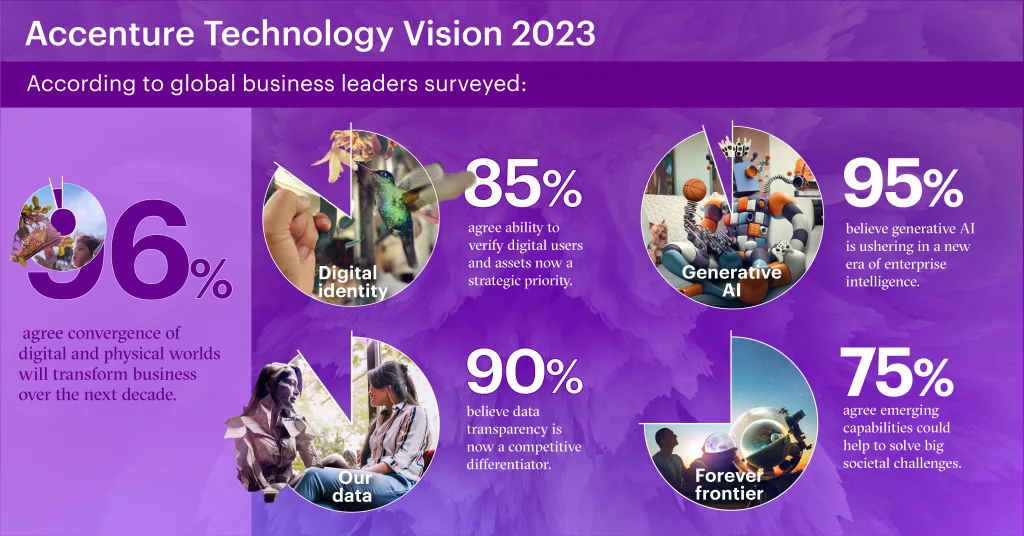There can no longer be any doubt that generative AI will transform enterprise intelligence. Anyone who has experimented with this technology will know just how powerful it has become; able to understand context and adapt to a wide range of tasks. With generative AI at our fingertips, we can work faster, smarter, and push the boundaries of creativity, says Andy Walker, global communications & media lead, Accenture.
Communications Service Providers (CSPs) are among those exploring how this new technology could help to drive efficiencies, support digital transformation, and ultimately unlock new opportunities for growth and innovation. Indeed, there are high hopes for generative AI across the telco industry. According to our Technology Vision 2023 report, nearly two thirds (64%) of CSP executives said they expect AI foundation models to improve customer service, and more than six in ten (61%) believe these models will accelerate new innovations.
So, what is the opportunity for CSPs? And how can they take the lead in this new era of enterprise reinvention?
The CSP opportunity
First, generative AI can help to improve the customer experience offered by CSPs. For example, customer service agents could use this technology to understand customer enquiries, simplify their responses, and deliver a more consistent tone of voice. This could help to create efficiencies at the same time as improving the quality of customer engagements generating an immediate return on investment. In addition, this approach will make sure the human touch remains, minimising customer frustrations and helping to build long-term loyalty.

Marketing is another area ripe for innovation, with generative AI making real-time personalisation a reality. For example, if a CSP is announcing a new roaming offer, they will be able to tailor advert text and imagery based on where someone is travelling. This will ultimately help to increase engagement and boost sales.
CSPs can also use this technology to speed up innovation in their networks. Traditional AI is already used to optimise network deployment design, planning, and orchestration, but generative AI brings new benefits such as designing and automating network site configurations, which engineers can easily validate or fine-tune. This will ultimately lead to faster time-to-market for new customer services and solutions.
The foundation for success
Many companies struggle to use AI more widely because they don’t have enough data to teach their AI systems. However, pre-trained AI models with “zero- and few-shot learning” abilities could help CSPs to overcome this challenge.
These are called foundation models: large AI models pretrained across data modalities (like text and images), rather than on a specific task. They can learn to complete new tasks within these data types with little to no extra training. Examples include large language models, such as GPT-3, and text-to-image generators, such as DALL-E 2 and Stable Diffusion.
It’s important for companies to figure out where they can use these pre-trained AI models to improve their operations. This involves deciding which tasks the AI models can help with, how they will access the models, and where they fit in the foundation model ecosystem. With 40% of all working hours potentially impacted by generative AI, it will be increasingly important for CSPs to build the talent pipeline with the skills to take foundation models, adapt them to business needs, and integrate them into applications.

For CSPs to be successful with generative AI, identifying the right role for foundation models will be key. Indeed, almost all (99%) CSPs agree that AI foundation models will play an important role in their organisations’ strategies in the next three to five years, and 97% also agree AI foundation models will enable connections across data types revolutionising where and how AI is used.
A four-step approach
To get the most out of any investments in generative AI, CSPs should consider following a four-step approach…

First, define the vision with a business-driven mindset and a people-first approach to identify priority use cases. Second, don’t be afraid to experiment with curated foundation models. Third, set out an activation strategy with a practical implementation roadmap and sustainable technology foundation. Finally, the adoption of generative AI brings fresh urgency to the need for every company to have responsible AI principles in place. This includes controls for assessing the potential risk of generative AI use cases at the design stage and suitable approach to embed responsible AI approaches throughout the business.
The final word
Generative AI has huge potential for CSPs. However, tapping into the power of these mega technologies calls for a major rethink of how companies work, and significant investments are needed in data, people, and customised foundation models. Business leaders must lead the change, starting now, in job redesign, task redesign and reskilling people.
The author is Andy Walker, global communications & media lead, Accenture.
Comment on this article below or via Twitter: @VanillaPlus OR @jcvplus






